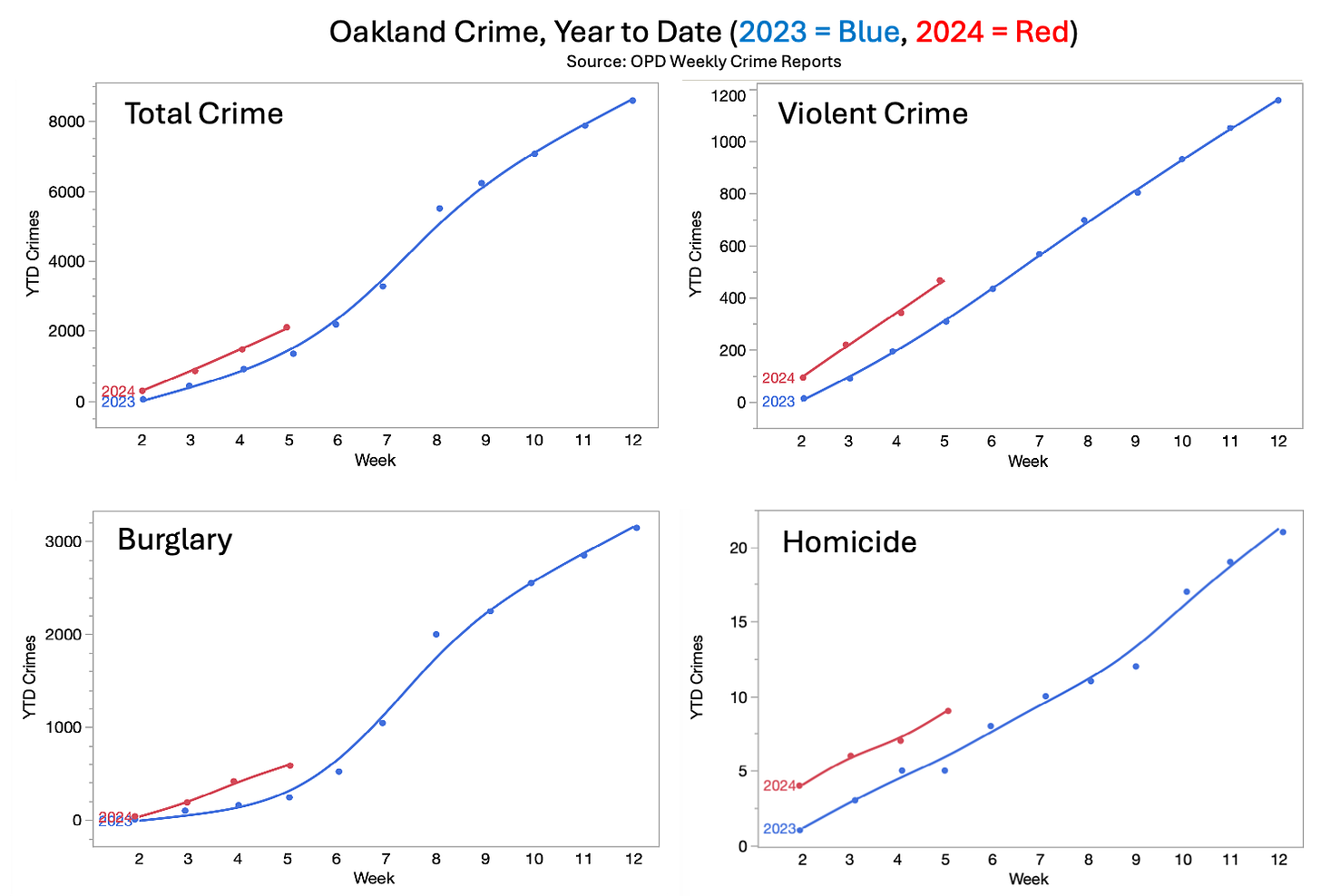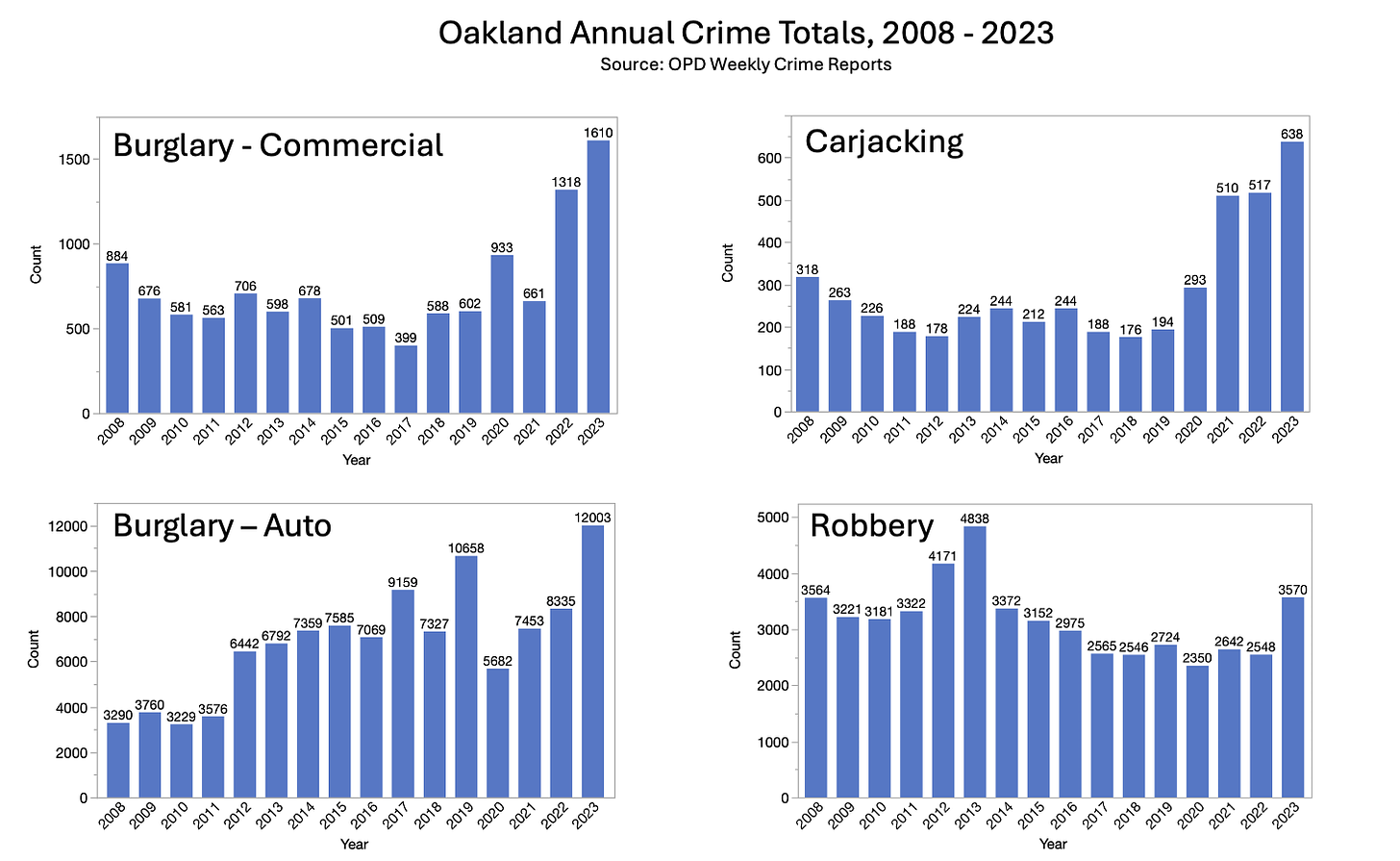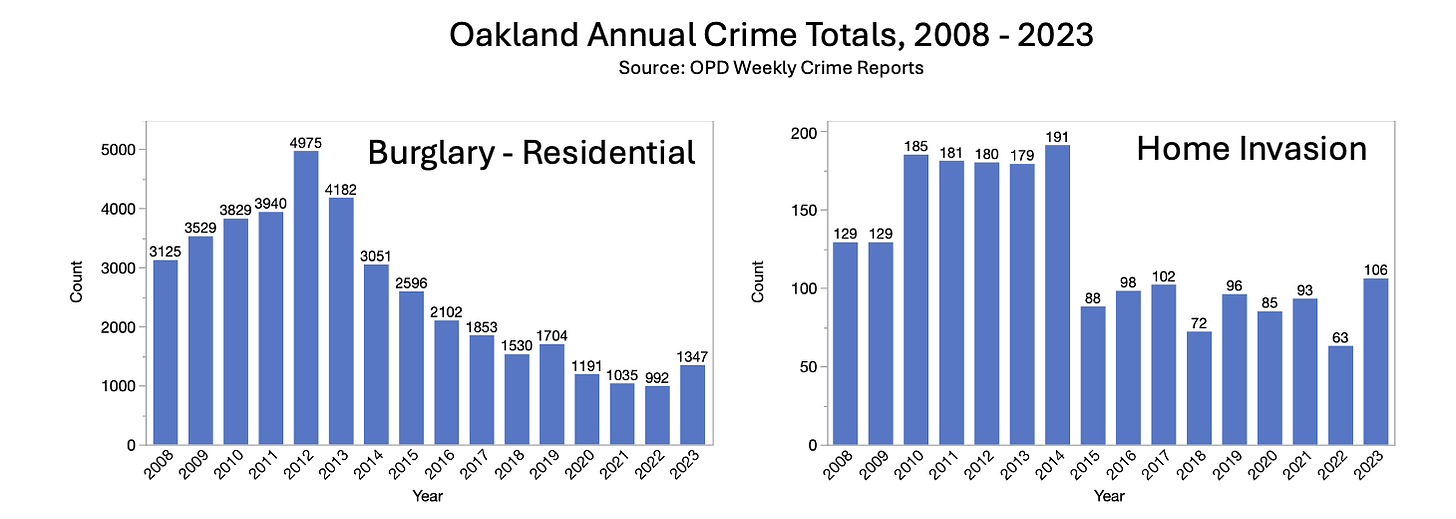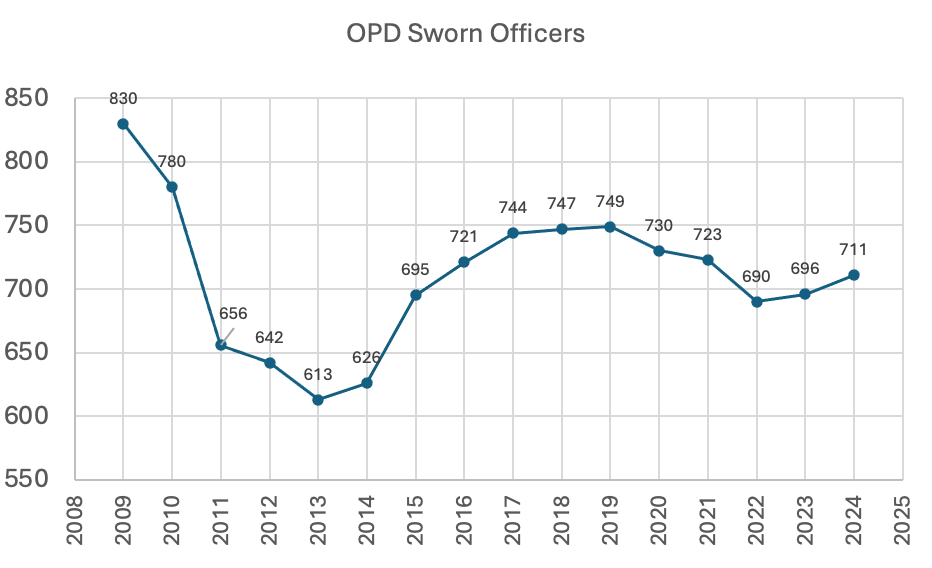Oakland’s Ongoing Crime Wave Is Like Nothing Before
It’s attacking the heart and lungs of the City
Oakland is no stranger to crime, but 2023 was different. The crime spree was more severe and more concentrated on the engines of commerce than ever before. It was an infection that struck the heart and lungs of the City. And so far in 2024, the infection shows no signs of abating. If not aggressively checked, it will accelerate a downward spiral of economic activity that is difficult to reverse.
Oakland is infamous for its seemingly endless cycles of crime and economic distress. But residents constantly remark that it feels different this time around; they know it’s different this time around.
“It blows my mind. I’ve lived Oakland my entire life and I’ve just never seen it like this.”
(Resident’s comment to KTVU after a smash and grab in Rockridge.)
FBI data shows that Oakland is an outlier as crime is falling across the nation. Oakland ranks at the top in per-capita property crime, 10th in murder, and shows the fastest rates of crime increases of cities over 300,000 people. In fact, 2023 was the largest year-on-year increase in property crime since the FBI began collecting UCR data in 1985, a span of time that includes crime waves during the crack epidemic and the COVID lockdown.
Sideshows go unchecked, women are dragged down the street during robberies, RVs are camped in front of houses for a year1, and public spaces look like a post-war apocalypse. A police officer was murdered in cold-blood while driving his unmarked vehicle by a crime scene. A latest insult, by no means unusual, was the fourth burglary of a store in Rockridge, this one accomplished by driving a truck through its wall.
Many businesses have closed shop, including In-N-Out and Denny’s, both long-standing establishments in underserved and under-invested neighborhoods. Large corporate employers Clorox and Kaiser have taken unilateral steps to protect employees, including guidance to stay in the building for lunch and providing escorted transport. Other businesses are banding together in partnership to explore private security options, including camera networks and private security forces. Yet others constantly implore the City to take more aggressive action. And many business just stopped reporting crime altogether for fear of losing their insurance.
But our City leaders appear not to see crime the same way as the residents and business owners. As late as July of 2023, leaders claimed that crime was dropping. Then their message shifted, arguing that the surge in crime “is not unique to Oakland” and “this, too, shall pass.” And finally, by October 2023, there was explicit recognition that crime is a real issue.
Yet, there has been little urgency to address the issue with extreme priority and focus. Two council members are campaigning for higher office.2 Public Safety Subcommittee meetings have been canceled repeatedly in the past 2 months.3 And the Mayor has made only small efforts toward crime fighting, such as actions to fix 911 (after receiving a letter from the State threatening to withhold funding), obtaining a small state loan to install license plate readers (for which funds have yet to be received), concentration of patrols in hotspots (which is already standard practice for Oakland Police), and reorganization of the Ceasefire program.
There has been no urgent prioritization of actions that are commensurate with the severity of the crime spree,4 no comprehensive problem analysis and coordinated multi-department and multi-agency strategy, and no systematic reporting of key progress indicators.5
Now a few weeks into 2024, the Mayor claims that crime trends are improving (here and here), and some folks on social media claim that media and residents are selectively presenting negative images of Oakland for personal or political gain.
So what is the reality of crime in Oakland? Is 2023 just another random spasm in Oakland’s never ending battles against crime and social distress? Or is it truly exceptional? Why does there seem to be a lack of urgency and focus among City leadership? Are things really improving in 2024?
These questions swirl because crime data comes mostly in dribs and drabs from breaking media reports and social media posts of the latest injustice. For folks who want to see the big picture about crime trends, it’s like trying to appraise a room by looking through the keyhole.
In this post, we aim to provide residents with a more complete perspective in order to place 2023 into historical context and to assess how 2024 is trending so far.6
Are things getting better in 2024? Given the crime data reported through January,7 there is no evidence of improvement. Crimes in 2024 appear to be equal or higher than 2023 in all 28 categories reported by OPD. Below are trends for four selected crimes categories. We note that these plots compare preliminary weekly crime totals for each year, and any observations are therefore also preliminary.8 More firm conclusions must wait until roughly mid-year at least with more complete data. Charts for all 28 crimes are provided in the footnote.9
Was 2023 really an exceptional year of crime? Even against the backdrop of Oakland’s high historical crime rates,10 2023 truly stands out as exceptional—particularly in property crimes (most notably commercial burglary), motor vehicle theft, carjacking, and homicides. Homicides reached 76% of the all-time high (experienced during the 1990s gun epidemic). Property crime reached 91% of the all-time high (experienced during the 1980s crack epidemic). And vehicle theft set records—30% higher than the highest rate ever recorded (experienced during the Great Recession).
These crimes hit most intensely in 3 areas of the City: (1) the Downtown area, (2) the Fruitvale area south of Foothill, and (3) East Oakland near International Boulevard between 82nd Avenue and 98th Avenue. (Source: 2008-2013 data, past week data.)
Looking deeper into a few of the crime subcategories—particularly those making headlines: commercial burglary, bipping (auto burglary), carjacking, and robbery—we see what makes 2023 stand out. All these crimes have reached unprecedented highs, except robbery which increased markedly in 2023 but not beyond precedent.
Most ominously, these crimes are concentrated on the City’s means of commerce.
The one bright spot in all of this bad news is a declining multiyear trend in residential burglary and home invasion. Both also jumped dramatically in 2023, but not enough to destroy the trend (we hope). While that is not comfort to the many victims of these crimes, it is worth calling out. It may be either a glimmer of hope, or a sign of the evolving motivations and mechanisms of criminals.
All of the data here simply confirm what residents already know in their hearts and in their experiences—that the latest wave of crime is real, it is ongoing, and it is like nothing they’ve experienced before.
Quite simply, crime in 2023 is different, and it is unusually destructive to the City’s health. It is exceptional not only in its severity, but also the types of crime committed. Today’s crimes are concentrated most intensely on the engines of commerce—the local businesses, and residents’ means of transport to those businesses. Is is an infection of the ‘heart’ and ‘lungs’ of the City, and it may be killing it.
Already 3,154 businesses did not renew their licenses in 2023,11 which may indicate closures, and new business license applications declined 25% YoY to 3,541.12 Without those stores, restaurants, artisans, and service providers, we lose the jobs that keep people here, and the commerce that breathes oxygen into the City’s culture. Large corporate employers will have little reason to locate into the City. Residents will have less reason to stay. We will lose the tax revenues that maintain our services and public spaces. We will snuff out the heartbeat of Oakland.
We cannot let this infection of our City’s heart and lungs continue. It needs absolute focus by the City Administration and Council, firm determination to solve the immediate problems, and prioritization of proven tools of crime fighting. As is the mantra of every good employer: “safety first.” And with that mindset, we can beat this infection.
Nikki Bas is a candidate for Alameda County Supervisor. Dan Kalb is a candidate for State Senate.
As an example of what could be done, see this community-drafted Resolution to initiate an intensified multi-departmental and transparent response to the public safety crisis. Neither the City or Council have been willing to consider the Resolution.
Examples of such objective and comprehensive performance metrics: San Jose Dashboards for Police and Homelessness, and San Francisco’s City Performance Scorecard.
In this article we do not weigh in on whether City policies are helping or hurting the crime issue. Policy assessment is deep and complex, demanding careful research to avoid contributing more speculation to the already noisy arena of public discourse. We hope to tackle some of these issues in future posts when we have the research in hand.
The data sources for this article are compiled from Oakland Police Department (OPD) Weekly Crime reports and the California OpenJustice Crimes and Clearances data. The OPD data provide statistics on a wide array of crimes, including Part 1 and some Part 2 crimes, but reach back only to 2008. The OpenJustice data are restricted to Part 1 crimes, but reach back to 1985.
These graphs show the preliminary weekly crime counts reported this year compared to the preliminary crime counts a year ago. By comparing preliminary data in both years, it resolves a common error in the interpretation of Year on Year (YoY) crime statistics. This error occurs because the weekly PDF files posted by OPD show the preliminary crime count for the current week and the final crime count one year ago. But preliminary counts will increase as additional crime reports from officers and the website are tabulated in subsequent weeks. The difference between preliminary and final tallies can be quite large.
To obtain a fair view of YoY trends, one must compare ‘apples to apples’—i.e. preliminary vs. preliminary data, or final vs. final data. We provide the former view above, since that’s all that is presently available. However we caution that preliminary data comparisons are just that—preliminary. A firm conclusion on how 2024 crime is evolving will have to wait until later in the year when the data is more complete.
Readers may also access a complete set of charts for all crime categories comparing 2023 vs. 2024 weekly trends, and for historical annual crime trends back to 2008. We also provide the compiled data from OPD and OpenJustice in Excel format for reader verification and further analysis.
On top of Oakland’s above average baseline crime, there have been five distinct phases of even more intense crime:
The crack epidemic of the 1980s and early 1990s, accompanied by very high property crime and rising homicides. This period was curtailed, in part, by federal tough-on-crime laws of the 1990s and also led to dramatic increases in incarceration rates;
The cheap-gun epidemic of the early 1990s (a doubling of the number of “Saturday Night Special” guns costing less than $100). This period overlapped the end of the crack epidemic and was associated with a several years of the highest murder rates ever seen in Oakland;
The Great Recession of 2006-2009, which is associated with a jump in violent crime and vehicle theft;
A precipitous drop in OPD staffing in 2012-2014 (char below), which is associated with a spike in violent crime;
COVID from early 2020 through mid 2022, which was associated with a jump in homicides, and more modest increases in violent crime and thefts.
Among all of these phases, the crime spree in 2023 stands out from all the others as a phase unto its own.
Oakland Police Department Sworn Officer Counts as of January of each year from 2009 to 2024. Data sources: OPD Staffing reports and updates from November 2018, May 2023 and November 2023.
Remarks by Council President Bas and Sherry Jackson, Oakland Revenue & Tax Administrator, at timestamp 1:13:10 in KTOP video of 1/23/24 Finance Committee meeting.
Report from Finance Department, page 3 of Attachment A: “Significant factors contributing to the Business Tax shortfall include recent economic conditions, such as the increase [in] commercial vacancy rates, the rise in borrowing interest rate, the decline in personal savings and taxable sales, as well as higher crime rates to local businesses, which are putting downward pressure on Business Tax revenues. New businesses formation in the City have been declining, with 3,451 new Business License applications received between January and September of 2023, compared to 4,632 during the same time-period in the previous year, resulting in a 25% year-over-year decrease for those periods.”














That you put in so many footnotes is a great sign of thorough work. Thank you for your time and efforts.
Thank you. It's all so disheartening, but having established facts at hand to combat the gaslighting from the social utopia/communism crowd is very helpful as people on either side of an issue can always joust with anecdotes. I'm hopeful things can be turned around, but for some reason there is a great asymmetry in that good leadership takes a long time to build things that bad leadership can wreck in a year.